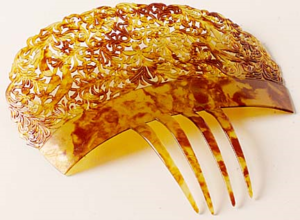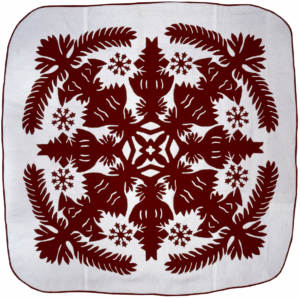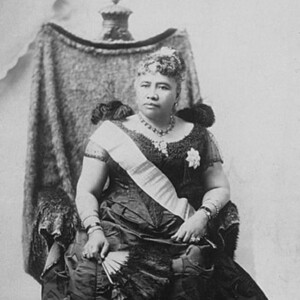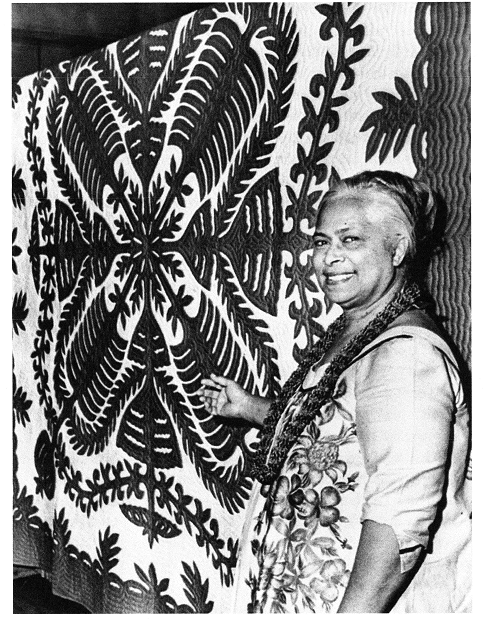
Quilts Honoring Women of the Hawaiian Monarchy
By Joyce D. Hammond
In this month of International Women’s Day when women’s achievements and contributions to others are celebrated, I wish to highlight quilts honoring royal Hawaiian women, namely: Queen Consort Ka‘ahumanu, Kamehemaha I’s chief wife; Queen Consort Emma, wife of King Kamehameha IV; Queen Consort Kapi‘olani, married to King Kalākaua; Princess Ka‘iulani, niece to the last two reigning monarchs of Hawai’i and heir apparent to the throne; and Queen Lili‘uokalani, the eighth and last reigning sovereign. Since most Hawaiian quilts have been made by women of Hawaiian descent or, in some cases, by women (and men) inspired by Hawaiian culture and quilt artistry, this essay also celebrates the quilt makers themselves.
Collections of Hawaiian quilts and quilt patterns from many sources reveal that the majority of Hawaiian applique quilts of the nineteenth, twentieth, and, now, twenty-first centuries have been inspired by natural elements of the islands such as flowers, leaves, rains, and beloved places. Another impressive and significant genre of Hawaiian quilt designs, however, are those which honor and immortalize the Hawaiian Monarchy which was established in 1810 by King Kamehameha I and overthrown in 1893 when Queen Lili‘uokalani was deposed by American businessmen with support from U.S. diplomatic and military personnel. Quilts incorporating the Hawaiian nation’s flag, those featuring elements of Iolani Palace, and others with names that reference specific Hawaiian kings are among the quilts associated with the Hawaiian Monarchy.
The Significance of Symbols
Quilt designs associated with the Hawaiian Monarchy overwhelmingly include royal symbols, many of which were earlier symbols of the ali‘i, the chiefly class of people in the Hawaiian Islands. These include kāhili (feather standards displayed or carried to indicate the presence of a person of high rank); the colors red and yellow, associated with the dominant colors of feather cloaks and capes exclusively worn by ali‘i; and the maile lei, made from the fragrant, shiny leaves of the maile plant, sacred to the Goddess Laka. These symbols, carried forward into the monarchy, appear in many quilt designs and quilt names honoring both royal women and men. Likewise, European-inspired symbols of royal crowns, perpetuating and conveying the wealth and potency formerly associated with high-ranking ali‘i, also appear in quilts associated with both sexes of the Hawaiian aristocracy.

A translucent tortoiseshell comb that belonged to Princess Bernice Pauahi. Honolulu Star Bulletin, October 8, 2001. Photo by FL Morris for the Star Bulletin.
Two quilt motifs, frequently incorporated into quilt designs and quilt names, pe‘ahi (fans) and kahi (decorative combs to secure the hair) are exclusively associated with female Hawaiian royalty. These personal accoutrements allude not only to the regal femininity of the royal women, but, given the legacy of fans and combs in indigenous Hawaiian culture and their prominence in European society of the nineteenth century, the articles can also be regarded as serving to strengthen the link between the Hawaiian past with the nineteenth century. In Hawaiian Antiquities (1903), native Hawaiian historian David Malo reported that female chiefs frequently made combs called huli-kua that were decorated with feathers from the feathered helmets of slain enemy warriors. Crescent shaped fans, beautifully fashioned from plaited fibers of various plants, were other personal articles associated with the chiefly class of people. Their shape, as Kamehiro suggests, may have developed from a metaphorical relationship between arching forms and sacred ancestry. Despite the different materials and styles of combs and fans that Hawaiian women owned in different time periods, the connections between the items and their use suggest an ongoing relationship of expressing nobility through highly desirable materials finely crafted.

Photo of “Ke Kahi O Ka‘iuIani” or The Comb of Ka‘iuIani created by Harriet Soong, 1997. Courtesy of MSU Museum. Photo by Douglas Elbinger.
Personal items of royal members of the Hawaiian Monarchy, like the personal possessions of former chiefs, were imbued with their owner’s mana, the spiritual life force energy. For this reason, I suggest, quilt designs incorporating fans and combs of royal Hawaiian women, like designs with kāhili, crowns and lei, served as excellent metaphors of a queen or princess’ mana. There are many Hawaiian quilts whose designs include combs, fans, crowns, lei, and/or kāhili belonging to royal women; the motifs are often included within a quilt’s name as well. Unique or rare designs of quilts associated with royal women may also include other types of personal possessions, such as “Ka‘iulani’s Comb and Bracelet” and “Kapi‘olani’s Parasol.”

Queen Liliʻuokalani with feather fan ca 1891. Hawaiʻi State Archives PP-98-12-006.
Quilt Names
One of the long-established conventions of Hawaiian quilting is naming a quilt. The names of quilts associated with royal women typically include the women’s names. The quilt name may also include identification of some or all of the symbols depicted in a quilt’s design. Although there are many quilt designs with the same or very similar names, the designs themselves may vary significantly. Such variation in early decades of quilt creation was probably tied to admonitions for quilt makers to alter a quilt’s pattern in some way to make it uniquely their own. Some quilts appear to closely replicate designs of other quilts but are known by different names. Over time, a particular design could accumulate several different names as identification of quilt names often reveals.
Given the investment in time and materials to make a Hawaiian applique quilt, the creation of a quilt conveys strong commitment to the motivations behind making it and its intended purpose. Since quilts have typically been bestowed upon others, strong messages of respect, love, admiration and appreciation can be conveyed, both toward the recipient and, in the case of quilts with royal themes, to members of the Hawaiian Monarchy. The many quilts that feature a continuous framing design around central motifs, for example, may be understood as including a kind of lei parallel to a natural lei placed around a person’s neck to express aloha. Some quilts’ names are explicit in using the word lei, as, for example, “Ka‘iulani’s Lei, Maile and Crown.”

Photo of “Lei O Ka‘iuIani.” Made by Hawaiian quilting teacher, Hannah Ku‘umililani Cummings Baker. Photo by Charles Okamura, The Honolulu Advertiser, 15 May 1967.
Below is a sample list of ten quilts that honor five royal woman by name and include references in the quilt names to all or only some of the royal symbols that appear in the design. So, for example, Mary Kauhoanoano’s quilt named “The Fans and Feather Banner [kāhili] of Kapi‘olani” includes crowns and maile lei motifs in addition to the kāhili and fans. I have included the quilt maker’s name (if known) and time period of origin. Sources for information regarding the quilts are included.
- Lei O Ka‘ahumanu (Lei of Ka‘ahumanu) created by Eme Mahikoa (sometime between 1876-1900), The Quilt Index online, https://quiltindex.org
- Ka‘ahumanu’s Crown and Kāhili created by Margaret Apiki Ajakuelo (ca. 1930) Mission Houses Museum Collection
- Kāhili Me Ka Peahi A Me Ka Lei Huapala O Queen Emma (Kāhili, Fan and Huapala Lei of Queen Emma) created by Rebecca Mahoe Haalou Medeiros (before 1960) The Quilt Index online, https://quiltindex.org
- Garden of Queen Emma, created by Meali‘i Kalama (n.d.) Wai’anae Library Quilt Pattern Collection
- Ka‘iulani’s Lei Maile and Crown, pattern created by Rose Pawai (n.d.) Wai‘anae Library Quilt Pattern Collection
- Ke Kahi O Ka Ka‘iulani (The Comb of Ka‘iulani) created by Harriet Momilani Kimseu Soong. 1997 The Quilt Index online, https://quiltindex.org
- Ka Peahi A Me Ke Kāhili O Kapi‘olani (The Fans and Feather Banner of Kapi‘olani) created by Mary Kauhoanoano (1930-1949) The Quilt Index online, https://quiltindex.org
- Hale Akala O Kapi‘olani (The “Bungalow” of Kapi‘olani ), creator unknown, (1901-1929) The Quilt Index online, https://quiltindex.org
- Lili‘uokalani’s Fans and Kāhili created by Therese Ka‘aimalani Isaacs Kapiko Quinn (1930-1949) The Quilt Index online https://quiltindex.org
- Lili‘uokalani’s Crown, Fan and Lei created by Wailani Johansen (1946) The Quilt Index online, https://quiltindex.org
Ongoing Inspiration
Many scholars think the earliest Hawaiian applique quilts were made by ali‘i. This is based on chiefly women’s bark cloth creation, elements of which were carried over into quilts and the fact that ali‘i controlled foreign goods, including imported cloth. Through time, as Western cloth became more available and sewing was widely expected of girls and women, the creation of Hawaiian quilts became more widespread among women.
Over time, Hawaiian quilts and their designs have been created with varying emotions and intentions. Some quilts with royal symbols made before 1893 were undoubtedly made in joyful celebration of the love and respect people felt for Hawaiian royalty. Many quilts after the overthrow of the kingdom commemorate the monarchy and reflect profound sorrow and loss. Of these, some may convey kaona, “hidden messages.” For example, some quilts associated with Queen Lili‘uokalani’s name that include fan motifs might possibly have referred to letters written to President McKinley in protest of Hawai’i’s annexation since, in code, the letters were referred to as “fans.”
A revival of interest in Hawaiian quilts in the 1920s and 1930s and a later “second wave” of revival in the 1970s, may be regarded as tied to a variety of motivations such as renewed interest in Hawaiian history, nostalgia for the past, embrace of Polynesian identity or interest in Hawaiian culture by quilters who have no Hawaiian ancestors or ties to the Hawaiian Islands as homelands.
Hawaiian quilts honoring royal Hawaiian women continue to be created. Although women still outnumber men as designers and quilters, men sometimes participate. John Serrao’s “Queen Ka‘ahumanu” quilt design, appliqued and quilted by Phyllis Hirata, and his quilt design, “Queen Lili‘uokalani,” appliqued and quilted by Hiroko Vaughan, are part of his Ali‘i Series. Ric Stark learned to make Hawaiian quilts from his aunty, Violet Hue, and now dedicates all of his quilts to Queen Lili’uokalani. Like Serrao, who incorporated new motifs into his work such as the lei noho palaoa (whale tooth pendant), Stark has infused new themes into his quilts. “He Kila Mo’i” (The Courageous Monarch), for example, commemorates Queen Lili‘uokalani’s royal visit to Kauai in 1891.
Applique quilts with symbols of royal Hawaiian women honor those remarkable women and their legacies. At the same time, the quilts themselves convey dedication and inspiration that quilt makers have taken from a uniquely Hawaiian form of expression.
Top photo: Queen Kapi‘olani and Princess Lili‘uokalani taken at Queen Victoria’s Golden Jubilee. The fan that the queen is holding may have a pandanus base with embellishments of feathers and other materials. Hawai’i State Archives PP98-11-008.

Joyce D. Hammond is a professor emerita of the Anthropology Department of Western Washington University. She is the author of Tīfaifai and Quilts of Polynesia (1986), “Hawaiian Flag Quilts” (1993), and other articles about Polynesian textiles published in academic journals. joyce.hammond@wwu.edu
Sources
Brandon, Reiko Mochinaga and Loretta G.H. Woodard. 2003. Hawaiian Quilts, Tradition and Transition. Honolulu: Honolulu Academy of Arts.
Hawaiian Quilting by Ric Stark, https://hawaiianquilter.com
Kamehiro, Stacy. 2007. “Hawaiian Quilts: Chiefly Self-Representation in Nineteenth-Century Hawai’i.” Pacific Arts, 3-5, 26-36.
Malo, David. 1951 (First published 1903). Hawaiian Antiquities (Moolelo Hawaii). Honolulu: Bernice P. Bishop Museum.
Severson, Don R., Michael D. Horikawa and Jennifer Saville, eds. 2002. Finding Paradise: Island Art in Private Collections. Honolulu: Honolulu Academy of Arts.
Serrao, Poakalani, John Serrao, Raelene Correia, and Cissy Serrao. 2007. The Hawaiian Quilt, The Tradition Continues. Honolulu: Mutual Publishing.
Silva, Noenoe K. 2004. Aloha Betrayed, Native Hawaiian Resistance to American Colonialism. London: Duke University Press.

